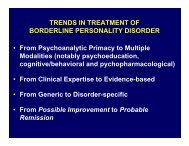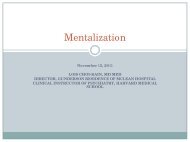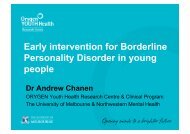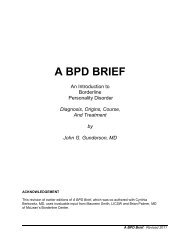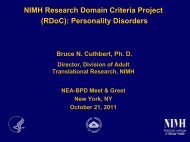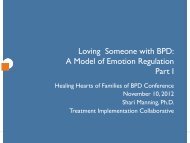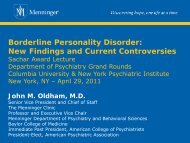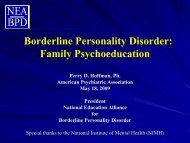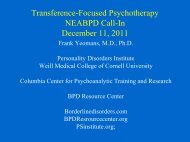Dr. John Oldham - Borderline Personality Disorder
Dr. John Oldham - Borderline Personality Disorder
Dr. John Oldham - Borderline Personality Disorder
You also want an ePaper? Increase the reach of your titles
YUMPU automatically turns print PDFs into web optimized ePapers that Google loves.
<strong>Borderline</strong> <strong>Personality</strong> <strong>Disorder</strong>NEA-BPD Meet and GreetNew York, NY – October 21, 2011<strong>John</strong> M. <strong>Oldham</strong>, M.D.Senior Vice President and Chief of StaffThe Menninger Clinic;Professor and Executive Vice ChairMenninger Department of Psychiatry and Behavioral SciencesBaylor College of Medicine;President, American Psychiatric Association
<strong>Personality</strong> = Temperament + Character
DSM-IV Definition of <strong>Personality</strong> <strong>Disorder</strong>An enduring pattern of inner experience andbehavior that deviates markedly from theexpectations of the individual’s culture. Thispattern is manifested in two (or more) of thefollowing areas:1. Cognition2. Emotions3. Interpersonal functioning4. Impulse control
<strong>Personality</strong> “Order” or “<strong>Disorder</strong>”QASince everyone has a personality, howdo we decide what a personality disorderis?Having too much or too little of normaltraits can cause problems in functioning(like high blood pressure or low bloodpressure).
<strong>Borderline</strong> <strong>Personality</strong> <strong>Disorder</strong> (BPD)APA DSM-IV Criteria(At least 5 must be present)1. Fear of abandonment2. Difficult interpersonal relationships3. Uncertainty about self-image or identity4. Impulsive behavior5. Self-injurious behavior6. Emotional changeability or hyperactivity7. Feelings of emptiness8. Difficulty controlling intense anger9. Transient suspiciousness or “disconnectedness”
Heterogeneity of BPD• DSM-IV - defined BPD is an extremelyheterogeneous construct (Est. 256 varieties)• Mix of unstable, stress-induced symptoms andstable personality characteristics (i.e.,dimensional traits)
Patients with BPD HaveSevere Impairment in Functioning• Common history of childhood trauma• Mistrustful of others, yet cling to others for“life support”• High internal levels of anxiety and distress• Stormy interpersonal relationships• High family stress• Difficulty keeping jobs• Overemotional and impulsive• Self-injurious behavior
High Suicide Risk in Patients with BPD8 – 10 % commit suicide60 – 70 % make suicide attempts
BPD Causes and Risk Factors• BPD evolves in the presence of biologicalvulnerability, psychological adversity, andsocial stressors.• No single factor accounts for the disorder. BPDcannot be understood without considering abroad range of risks.• One cannot assume that patients with a typicalclinical picture will have a specific pattern ofrisk.• One cannot assume that patients with a specificpattern of risk will develop BPD.- Paris, 2008
BPD as a <strong>Personality</strong> <strong>Disorder</strong>Emerging from the Interaction ofUnderlying Genetically-Based TraitsImpulsive aggression and affective instability =heritable endophenotypes that would contributesignificantly to development of BPDSiever et al., 2002
<strong>Borderline</strong> <strong>Personality</strong> <strong>Disorder</strong>Insecure AttachmentEndophenotypes• Impulsive aggression• Affect instabilityUnstable InterpersonalRelationships• Excessive intensity• Overvalued Expectations• Unfounded Anxieties• Cognitive-Perceptual Symptoms
Amygdala-Prefrontal Disconnectionin BPDNormal: prefrontal cortex → inhibitory controlover amygdalaBPD: Absence of normally tight coupling= disconnect between orbital frontalcortex and amygdala→ failure to downregulate amygdala inresponse to aversive stimuli- New et al., 2007
NormalCortex (thought center)+ -Amygdala (emotion center)
<strong>Borderline</strong>Cortex (thought center)+ -Amygdala (emotion center)
BPD Treatment• Psychotherapy is the treatment of choice• Many types of psychotherapy are effective• Medications can help but should beadjunctive, symptom-targeted, and usuallytime-limited
APA Practice Guidelines Work Group on<strong>Borderline</strong> <strong>Personality</strong> <strong>Disorder</strong><strong>John</strong> <strong>Oldham</strong>, M.D. (Chair)Glen Gabbard, M.D.Marcia Goin, M.D., Ph.D.<strong>John</strong> Gunderson, M.D.Paul Soloff, M.D.David Spiegel, M.D.Michael Stone, M.D.Katherine Phillips, M.D.
Types of Psychotherapy for BPD1. Mentalization-Based Therapy (MBT)2. Dialectical Behavior Therapy (DBT)3. Schema-Based Therapy (SBT)4. Transference-Focused Therapy (TFT)5. General Psychiatric Management (GPM)6. Cognitive Behavioral Therapy (CBT)7. Systems Training for Emotional Predictabilityand Problem Solving (STEPPS)
Overview of Psychotherapy for BPD• Four manualized psychosocial treatments1. Dialectical Behavior Therapy2. Mentalization-Based Therapy3. Schema-Focused Therapy4. Transference-Focused Therapy• All are effective to ↓ selected aspects of borderlinepsychopathology, especially self-mutilation and suicideattempts• Symptoms relating to temperament are relatively slowto resolve- Zanarini, 2009
Psychotherapy, involving learning andmemory, leads to:• Gene activation• Protein synthesis• Increased intercellular connections• Neurogenesis
Four Essentials of Effective BPDTreatment1. Establishment of a strong therapeutic alliance2. Availability of skilled therapists3. Funds / insurance coverage4. TimeNOTE: THERE IS NO QUICK FIX
Greatest Stressors for Professionals1. Patient anger2. Suicide attempts3. Threats of suicideHellman et al.,1988
Imagine the Impact of This“<strong>Borderline</strong> <strong>Personality</strong> <strong>Disorder</strong>:The <strong>Disorder</strong> that Doctors Fear Most”Cover, Time Magazine January 19, 2009
Should the Name be Changed?“<strong>Borderline</strong> personality disorder by any othername would still be as real, as disabling, and asnecessary to treat, as other serious mentalillnesses.”- Thomas Insell, MDDirector, National Institute of Mental HealthDirector’s Post, April 19, 2010
Longitudinal course
Collaborative Longitudinal <strong>Personality</strong><strong>Disorder</strong>s Study (CLPS)• 5 Collaborative SitesBrown (Shea), Columbia (Skodol), Harvard (Gunderson),Yale (McGlashan), Texas A&M (Morey)• 668 Patients Recruited Originally (+65)STPD (N= 86), BPD (N=175), AVPD (N= 158),OCPD (N= 154), MDD and no PD (N= 95)• Followed Longitudinally for >14 YearsTo determine the stability of symptoms, diagnoses,dimensions, and functioning and to determine the predictorsof clinical course
100Diagnostic Remission (cumulative): Lifetest survival estimates908070% Remitted60504030Remission definition:BPD > 12 mo20100 1 2 3 4 5 6 7 8 9 10Years of Follow-upGunderson et al.
Functional Remission (GAF > 70 for 12 months):Lifetest survival estimates10% Remitted80604020BPDOPDMDD00 1 2 3 4 5 6 7 8 9 10Years of Follow-upGunderson et al., Arch Gen Psych, 2011
Cost-effectiveness of BPD Treatment• Patients with BPD given individualpsychotherapy 2x/wk for 1 year• ↓ work absence (4.47 months vs. 1.37month)• ↓ cost of health services (net savings of$18,000 per patient)Hall et al., J Ment Health Policy Econ, 2001
The Good News• BPD is treatable• Treatment works• With good treatment, and enough time,patients get better
Thank you for your interest!







